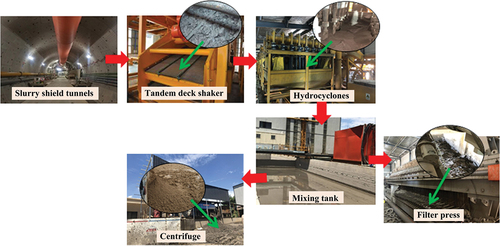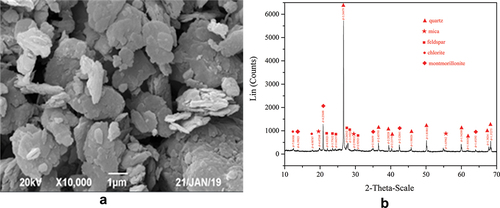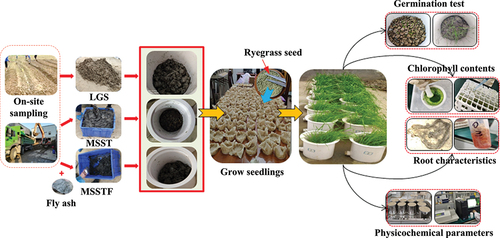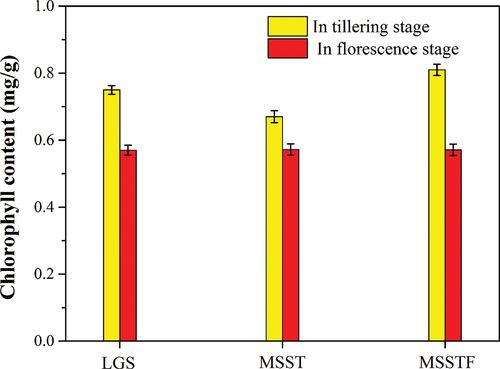 ?Mathematical formulae have been encoded as MathML and are displayed in this HTML version using MathJax in order to improve their display. Uncheck the box to turn MathJax off. This feature requires Javascript. Click on a formula to zoom.
?Mathematical formulae have been encoded as MathML and are displayed in this HTML version using MathJax in order to improve their display. Uncheck the box to turn MathJax off. This feature requires Javascript. Click on a formula to zoom.ABSTRACT
Muck from slurry shield tunnels (MSST) is a complex mixture. Directly transporting this muck to dumping grounds not only increases the costs but also raises environmental concerns due to its unusual properties. In this study, a formula has been studied that can turn the MSST into an environment friendly soil. The treatment process can realize the harmless disposal and effective utilization of MSST. In the laboratory study, three different types of growing media (MSST, MSST with 1% fly ash, and local garden soil) were used to grow ryegrass in a series of pot experiments, and the seed germination, chlorophyll content, root characteristics, root activity and physical and chemical properties of the growing media were examined. The results showed that MSST and MSSTF (MSST with added fly ash) can be used as a soil matrix for ryegrass because they exhibited a technical performance comparable to that of local garden soil (LGS), and the physicochemical parameters of the soil matrix were enhanced compared with the standard values of CJT 340–2011. Although the additive (fly ash) and different types of substrates can affect plant growth and the properties of harvested soils, the level of variation decreases with the stage of growth. As waste recycling is the primary objective of this work, MSSTF is the ideal substrate to use. The treatment process is easy to handle, and represents a sustainable option and an environmentally friendly, beneficial use of MSST.Implications: Muck discharged from slurry shield tunnel construction has put great pressure on the environment and construction cost because of a large number shield tunnels emerging in cities. Directly transporting the discharged muck waste to dumping site not only increases the machinery and labor costs but also raises environmental concerns. Therefore, we explore the way of recycling the discharged muck from slurry shield tunnel as a growth medium for landscaping which was proved to be feasible by a series of pot experimental study. Recycling the discharged muck from shield tunnel as the growth medium for landscaping instead of using purchased raw materials not only can dramatically reduce project costs but also can obviously minimizing the consequent environment pollution. Such technology can contribute to sustainable developments and cleaner construction of infrastructures.
Introduction
In many cities across China today, the slurry balance shield machine is commonly used to excavate large tunnels in sand or clay layers with a high water content (or underwater), as its performance exceeds that of conventional drill-and-blast and EPB shield methods. Examples include the Nanjing Yangtze River Tunnel (Min et al. Citation2015), Shanghai Yangtze River Tunnel (Shen et al. Citation2009), Yangzhou Slender West Lake Tunnel (Wang et al. Citation2017), Nanjing Yangtze River Tunnel on Metro Lines 3 and 10 (Lin, Wu, and Xia Citation2015), etc. Several million tons of muck are produced every year by slurry balance shield excavations in China, and almost all of this muck is treated as waste, requiring sites, equipment and personnel for treatment, transportation and disposal, which adds to the cost of the project (Bellopede et al. Citation2011). Moreover, with no efficient treatment of the muck during transport and landfill, the muck causes severe ecological damage (including groundwater and air contamination), and it is difficult for traditional muck treatment disposal methods to meet the requirements of the Environmental Protection Agency (Katsumi Citation2015). Therefore, much research on the reuse of muck from slurry balance shield tunnels (MSST) has been conducted. For example, MSST has been used as a raw material in construction (Gertsch et al. Citation2000), as a filler material (Tokgöz Citation2013), and as the main component of backfill grouting materials (Zhou et al. Citation2017).
The construction of the cross-river slurry shield tunnel in Hangzhou provides a good opportunity to study such applications. Approximately 5.7 w cubic yards of MSST were generated in this project, and minimizing the financial outlay and environmental impact of treating this MSST is one of the most important challenges for the management department. Some research has been conducted on the utilization of MSST as a recycled material in different fields, but few data are available on the application of these materials for landscaping. Waste mud, which is produced in different fields, has been used as a soil resource for landscaping (Whitaker, Penn, and Warren Citation2016; Zha et al. Citation2018). Moreover, fly ash has been used as an additive in soil that can significantly promote the growth of organisms (Gupta et al. Citation2007). Inspired by these successful applications, we suggest that recycling MSST with added fly ash as a sustainable soil resource for landscaping may be the most feasible application of this waste product and could help preserve natural resources and reduce costs.
In this paper, the main objective was to examine the possibility of reusing MSST with added fly ash to make a soil matrix for landscaping using a series of experiments. Firstly, designing a growth medium for landscaping using treated MSST, and the physical, chemical, microanalysis, composition and geotechnical aspects of MSST was test; Then, evaluation of the germination and growth of ryegrass seeds planted in MSST using a pot experiment. The results proved the environmental quality standard for soils acceptance of this new growth medium for landscaping.
Production of MSST
A frequently used method for processing MSST is stabilization using a filter press or solidification with flocculants. provides an overview of the steps to produce MSST in slurry shield tunnel sites in Hangzhou, China.
The first step is to screen large diameter waste from the MSST received from the slurry balance shield tunnel site using a prescreener (particle size > 2 mm). The working principle of the prescreener is that a tandem deck shaker (consisting of a 180 mm×40 mm upper sieve plate and a 1830 mm×4270 mm×3 mm lower sieve plate) produces the vibration necessary for screening. Because the MSST still contains considerable sand after the removal of large diameter waste, the MSST must be further treated with hydrocyclones to remove more of the sand.
The second step is to separate the sand from the MSST received from the prescreener using hydrocyclones. It should be noted that the prescreening with hydrocyclones is divided into a primary hydrocyclone (which separates out particles 74 μm~2 mm) and a secondary hydrocyclone (which separates out particles 20/45 μm~74 μm). The primary hydrocyclone uses a φ500 variable cone angle hydrocyclone for separation, and the feed pressure is controlled at 0.15 ~ 0.18 Mpa. The secondary hydrocyclone uses an imported small diameter multicone (150 mm) and a fishtail device, and a vacuum-regulating device is included to regulate the underflow concentration.
The final step is to separate water from the MSST to lower the moisture content (to less than 25%) using a centrifuge or filter press; this form of MSST is convenient for truck transportation in the form of stockpiles. To improve the efficiency of MSST dewatering, 0.2% polypropylene was added to the MSST prior to centrifugation.
Determination of basic properties of the MSST
Physical and mechanical properties
The MSST was obtained from slurry shield tunnel sites in Hangzhou, China. In appearance, the MSST is a brownish-black paste with a slight odor. The physical properties and particle size distribution of the MSST are summarized in . The particle size distribution of MSST is broad; 20.89% is less than 0.005 mm, and the proportion of powder particles and clay particles is high. Hence, the MSST was considered silty clay as per China GB/T50145, 2007.
Table 1. Physical properties and particle size composition of MSST
Chemical and hydrophysical characteristics
The characteristics of the MSST and local garden soil (LGS) are summarized in , and the tests were performed according to the standard of NYT 1121.6–2006. The pH of the MSST was close to neutral. Moreover, the MSST exhibited a relatively high organic matter content and low levels of hazardous pollutants, and the heavy metal contents were all well below the Environmental Quality Standard for Soils (GB15618-2008) of the State Environmental Protection Administration of China (SEPAC). These results indicate that MSST has potential as a readily available growth medium for landscaping.
Table 2. Chemical and hydrophysical characteristics of the MSST
Microanalysis and composition
The microanalysis of the MSST was performed using scanning electron microscopy (SEM) (TESCAN Ltd., Brno, Czech). The SEM showed that the MSST had a loose microstructure, which is conducive to root respiration of crops and surface water infiltration (). shows the X-ray powder diffraction (XRD) analyses of MSST. The major mineral constituent of the MSST was quartz (63.74%); mica (11.64%) and feldspar (14.72%) were identified as minor minerals, and the least abundant minerals were montmorillonite (4.23%) and chlorite (5.62%). It was not surprising that the MSST is primarily composed quartz with a certain amount of montmorillonite because the slurry shield tunnel is situated primarily within the clay silt layer and the silt layer.
Evaluation of the MMST as a growth medium for landscaping
Experimental design
The study was conducted in a greenhouse located in Changsha, China. According to the data provided by the nearest pluviometric observatory, the average annual temperature is 17.9°C and the average annual relative humidity is 78%. Three different materials were used to make the growing medium mixtures: MSST, MSSTF (fly ash added to the MSST in a mass ratio of 0.01:1), and local garden soil (LGS). Ryegrass was selected to evaluate plant growth on the growing medium mixtures. The protocol for the experiment was as follows. The MSST and LGS were aged in the greenhouse for 7 d, and then, equal quantities (by weight) of MSST, MSSTF, and LGS were homogenized separately in a drum mixer for one hour. The freshly prepared growing media were poured into pottery pots and left to cure for 7 d prior to planting. Seeds were sown in each pot and germination and growth were recorded. For the three growing medium mixtures, the experimental design consisted of six random blocks with 100 seeds per substrate grown in 6430 ml pottery pots. One day before the planting experiment, the seeds were soaked in distilled water and grown to seedlings in a petri dish; all experimental pots were illuminated with natural daylight and watered identically. The root characteristics (total root length, total root surface area, average root diameter, root volume and number of root tips), root activity, chlorophyll content and growth were recorded at different growth stages, and soil was collected for further analysis (organic matter, pH, total nitrogen, total potassium, total phosphorus, alkali hydrolyzed nitrogen, available phosphorus and available potassium) after plant removal. A schematic of the experiment process is shown in .
Testing procedure
Germination based on cotyledon emergence was recorded every 24 h for 10 days. The percent germination (GP) was defined as , where G10 is the number of germinated seeds on day 10, and TS is the total number of seeds planted. The chlorophyll content in the plant was determined spectrophoto metrically (Biehler, et al., Citation2010). The blade was rinsed with water and cut to approximately 2 mm, then placed in a mixture of acetone and absolute ethanol (in a 1:1 weight ratio). The absorbance of the sample was determination using a UV spectrophotometer (UV-1220, China). The chlorophyll content of the sample was calculated using the Lambert-Beer law (Manzoor et al. Citation2021; Vogelmann and Evans Citation2002). The root characteristics included total root length, average root diameter, the number of root tips and root activity. The root analysis software WinRhizo (type v2013e, China) was used to quantify root characteristics (total root length, average root diameter, and number of root tips) at different growth stages. The root activity was determined using the TTC reduction method (Knievel Citation1973). The pH of the soil was determined with an electric potentiometer (Acevedo et al. Citation2014), and the organic matter content was determined using the dichromate volumetric method (Silva et al. Citation2016; Wahid et al. Citation2021). The total N was determined using the semimicro Kjeldahl method (Menefee and Overman Citation1940), total K was determined using the NaOH melt flamer method, total P was determined using the sulfuric acid-perchloric acid digestion method (Yu and Ho Citation2009), and available N was determined using the Conway method (George et al. Citation1973; Gul et al. Citation2020).
Results and discussion
The germination rate is an important index that is used to evaluate seed quality (Danneberger et al. Citation1992). The ryegrass seed germination results (based on cotyledon emergence) showed little difference among the three growing media. The LGS media showed very high seed germination (95.67%), and the MSSTF media was only marginally less (94.22%) and was greater than that in the MSST (92.87%). In all treatments, ryegrass seed germination exceeded 90%. Therefore, MSST with added fly ash achieved a better germination rate than MSST.
The chlorophyll content is closely related to the photosynthetic rate and the transformation of absorbed nutrients (Jo et al. Citation2011). Therefore, the chlorophyll content of leaves is an important index that can reflect the growth of a plant. shows the chlorophyll contents of ryegrass at different stages of growth; significant differences were found among the stages of growth. Overall, the leaves of all plants in all growing media at all stages appeared healthy and did not shown signs of yellowing or dying. During the tillering stage, the highest chlorophyll content was found in the MSSTF treatments followed by LGS, and the lowest chlorophyll content was found in the MSST. However, the total chlorophyll of plants in the MSST, MSSTF and LGS treatments were 0.580 mg/g, 0.575 mg/g and 0.573 mg/g, respectively during florescence stage. This finding indicates that the ryegrass did not show an increase in chlorophyll content during the flowering stage with the addition of fly ash. Overall, the ryegrass grown in MSST, MSSTF and LGS showed high chlorophyll contents, and they did not show differences at different stages of growth.
The root system can reflect plant utilization of the soil environment. As shown in , there was little variation in total root length and the number of root tips at different stages of growth among the three treatments. The total root surface area of ryegrass at different stages of growth was measured for the three treatments, and the results are shown in . In general, the total root surface area in the LGS treatments was intermediate between the MSST and MSSTF treatments, and the fly ash had a positive effect on the total root surface area at the tillering stage, but had a negative effect on the total root surface area at the florescence stage. The root activity of ryegrass is depicted in . The root activity was significantly different for the different types of culture medium (MSST, MSSTF, and LGS). However, the degree of variation tended to decrease with the stage of growth, i.e., the roots adapted to the MSST.
Figure 5. Root characteristics and root activity of ryegrass in tillering stage and florescence stage: (a) total root length; (b) number of root tips; (c) total root surface area; (d) root activity.
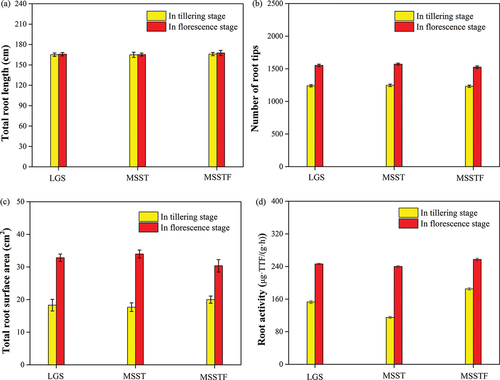
Organic matter is the primary source of plant nutrients and the basis for soil fertility and volume and is therefore an important indicator of soil quality (Gul et al. Citation2019; Mukhtar et al. Citation2020). Nitrogen, phosphorus and potassium are important factors determining plant growth. In addition, if the pH is too high or too low, it has adverse effects on both plant growth and the environment. The organic matter content, total nitrogen, total potassium, total phosphorus, alkali hydrolyzed nitrogen, available phosphorus, available potassium and pH of the growing media at the florescence stage are shown in . The organic matter content in the soil tended to decrease with the stage of growth and differed depending on the type of substrate; the highest levels were present in MSSTF, the second highest levels were found in MSST, and the least organic matter was found in LGS. Several studies have demonstrated that plants will absorb a certain amount of organic matter in the process of growth, which suggests that the MSSTF is more favorable for the growth of plants. The available potassium, total potassium and available phosphorus were related to the additive (fly ash) and the type of substrate. However, the total nitrogen, total phosphorus and alkali hydrolyzed nitrogen were only related to the type of substrate. Overall, the physicochemical parameters in the cured mixtures or harvested soil during the florescence stage were much higher than the standard values of CJT 340–2011. Moreover, the pH of LGS, MSST and MSSTF during the florescence stage was 7.03, 7.01 and 7.20, respectively. The difference in pH among the substrates tended to decrease with the stage of growth due to the successive applications of irrigation water; all pH values remained within the range considered suitable for woody plant container production.
Table 3. Physicochemical parameters of the mixtures
Conclusion
(1) The MSST in slurry shield tunnel sites in Hangzhou is similar to typical growth medium in macro properties and microaspects, which manifest the possibility direction of discharged soil recycling. MSST has a relatively high organic matter content and plastic limit, low levels of hazardous pollutants and heavy metals, and is a silty clay material, consisting primarily of quartz, mica and feldspar. Because the physical and mechanical properties of MSST satisfied the Environmental Quality Standard for Soils (GB15618-2008), it has reuse potential as a readily available landscaping soil matrix.
(2) A series of pot experiments suggest that MSST and MSSTF have a technical performance comparable to that of LGS and can be used as a soil matrix for ryegrass. Specifically, MSSTF would be the preferred growing medium from an economical and environmental perspective. The additive (fly ash) and the different types of substrate can affect plant growth and harvested soil properties, but this variation decreases with the stage of growth.
(3) Overall, the reuse of fly ash mixed with MSST as a growth medium for landscaping can provide a new approach to sustainably managing both categories of waste. Such an approach can dramatically reduce project costs for raw materials and can also minimize the consequent environmental pollution. This work opens the door for the reuse of drilling residuals to extend the useful lifecycle of this material as a low-cost, simple, sustainable management method. However, it should be pointed out that, for recycling the discharged soil as growth medium for different types of vegetation, the environmental quality standards and the additive should be re-scheduled.
Data availability statement
Some or all data, models, or code that support the findings of this study are available from the corresponding author upon reasonable request. https://tmxy.csuft.edu.cn/szdw/fjslm/202104/t20210419_110140.html.
Disclosure statement
No potential conflict of interest was reported by the author(s).
Additional information
Funding
Notes on contributors
Cong Zhang
Cong Zhang is an associate professor of Central South University of Forestry and Technology, China. In 2019, he graduated from Central South University with a doctoral degree in engineering. His research interest is mainly focus on research and development of new grouting materials, numerical analysis method of grouting, and the rehabilitation of tunnels and underground structures. He has presided over and participated in more than 10 projects entrusted by the state, provincial and ministerial level, as well as enterprises and companies, also won the second prize of science and technology progress of Ministry of Education in 2019 (in seventh place). In addition, he has published more than 30 journal papers indexed by SCI/EI, authorized 10 national patents.
Xu Liu
Xu Liu is a graduate student of Central South University of Forestry and Technology, China. His research interest is mainly focus on research and development of new grouting materials, numerical analysis method of grouting, and the rehabilitation of tunnels and underground structures. He has participated in more than 10 projects entrusted by the state, provincial and ministerial level, as well as enterprises and companies.
Jinyang Fu
Jinyang Fu is an associate professor of Central South University, China. He was awarded his PhD from Technical University Bergakademie Freiberg, Germany in 2014. His research interest is mainly focus on tunnelingl-ground-structure interaction, numerical analysis method of underground engineering, and the health detection of underground structure by computer machine vision. He presided projects granted by the National Natural Science Foundation of China, the Hunan Natural Science Foundation, and the general and special projects suppoted by the China Postdoctoral fund. As a research backbone, he has participated 2 general projects of NSFC, 1 key R & D plan of the 13th five year plan, and otherd in more than 10 scientific research projects supported by enterprises. He also served as the director of underwater tunnel engineering branch of China Society of rock mechanics and engineering, Secretary General of construction management and youth work Science and Technology Forum of tunnel and underground engineering branch of China Society of civil engineering, etc., and won the second prize of science and technology progress of Ministry of Education in 2019 (in third place), paper award of International Youth Academic Forum of St. Petersburg University of mining, Russia, and excellent paper of Guangdong highway society: He published more than 20 journal papers indexed by SCI/EI, authorized 5 national patents, and invited to serve as reviewers for Int J Geomech, J Performance Constr Fac and other journals.
Junsheng Yang
Junsheng Yang is a professor and doctoral supervisor of Central South University, China. In 1996, he graduated from Central South University of Technology (now Central South University) with a doctoral degree in engineering. He has successively been listed as the young backbone teacher of universities in Hunan Province (1998), the discipline leader of universities in Hunan Province (2005), the new century 121 talent project of Hunan Province (2008) and the new century excellent talent support plan of the Ministry of Education (2008). He mainly engages in the teaching and research work of tunnel and underground engineering, undertaking undergraduate and postgraduate teaching tasks. His academic research includes: impact assessment and risk control of sensitive structures adjacent to tunnels, treatment of tunnel diseases and quality defects, construction mechanics and risk assessment of tunnels and underground works, shield construction technology, dynamic information construction of tunnels and underground works, foundation of geotechnical mechanics, etc. He has presided over and participated in more than 50 projects entrusted by the state, provincial and ministerial level, as well as enterprises and companies, also won more than 10 science and technology progress awards and published more than 200 academic papers and 1 monograph. In addition, he is also as the editor in chief to compile 5 ASCE proceedings and published 5 textbooks or anthologies.
Linyi Li
Lin-yi Li obtained his BSc degrees in Civil Engineering from Central South University, China, in 2016. Now, he is a PhD candidate in Civil Engineering at Central South University, China. He has presided over and participated in than 10 projects entrusted by the state, provincial and ministerial level, school level, as well as enterprises and companies. In addition, he is published more than 10 journal papers indexed by SCI/EI, authorized 9 national patents
Yipeng Xie
Yipeng Xie is a doctoral candidate of Central South University, China. His research interest is mainly focus on mechanical behavior of granular soils and its grouting reinforcement. He has participated in more than 10 projects entrusted by the state, provincial and ministerial level, as well as enterprises and companies. In addition, he has published more than 10 journal papers indexed by SCI/EI.
References
- Acevedo, I., J. Contreras, R. Gonzalez, and O. Garcia. 2014. Effect of the application of organic matter on the physical and chemical properties of a garden floor. Revista De La Facultad De Agronomia 31 (3):325–40.
- Bellopede, R., F. Bruscor, P. Oreste, and M. Pepino. 2011. Main aspects of tunnel muck recycling. Am J Environ Sci 7 (4):338–47. doi:https://doi.org/10.3844/ajessp.2011.338.347.
- Biehler, E., M. Frédéric, L. Hoffmann, E. Krause, and T. Bohn. 2010. Comparison of 3 spectrophotometric methods for carotenoid determination in frequently consumed fruits and vegetables. J. Food Sci. 75 (1):55–61. doi:https://doi.org/10.1111/j.1750-3841.2009.01417.x.
- Danneberger, T. K., M. B. Mcdonald, C. A. Geron, and P. Kumari. 1992. Rate of germination and seedling growth of perennial ryegrass seed following osmoconditioning. HortScience 27 (1):28–30. doi:https://doi.org/10.1007/BF00026807.
- George, S., J. N. Carter, E. C. Simpson, and D. E. Schwaninger. 1973. Nitrate determination by a modified Conway Microdiffusion method. J. Assoc. Off. Anal. Chem. 56 (6):1365–68. doi:https://doi.org/10.1093/jaoac/56.6.1365.
- Gertsch, L., A. Fjeld, B. Nilsen, and R. Gertsch. 2000. Use of TBM muck as construction material. Tunnelling Underground Space Technol. 15 (4):379–402. doi:https://doi.org/10.1016/S0886-7798(01)00007-4.
- Gul, I., M. Manzoor, I. Hashmi, M. F. Bhatti, J. Kallerhoff, and M. Arshad. 2019. Plant uptake and leaching potential upon application of amendments in soils spiked with heavy metals (Cd and Pb). J. Environ. Manage. 249:109408. doi:https://doi.org/10.1016/j.jenvman.2019.109408.
- Gul, I., M. Manzoor, J. Kallerhoff, and M. Arshad. 2020. Enhanced phytoremediation of lead by soil applied organic and inorganic amendments: Pb phytoavailability, accumulation and metal recovery. Chemosphere 258:127405. doi:https://doi.org/10.1016/j.chemosphere.2020.127405.
- Gupta, A. K., S. Dwivedi, S. Sinha, R. D. Tripathi, U. N. Rai, and S. N. Singh. 2007. Metal accumulation and growth performance of phaseolus vulgaris grown in fly ash amended soil. Bioresour. Technol. 98 (17):3404–07. doi:https://doi.org/10.1016/j.biortech.2006.08.016.
- Jo, W., Y. Son, H. Chung, N. J. Noh, T. K. Yoon, S. Han, S. J. Lee, S. K. Lee, K. Yi, and L. X. Jin. 2011. Effect of artificial warming on chlorophyll contents and net photosynthetic rate of quercus variabilis seedlings in an open-field experiment. J. Korean For. Soc. 100 (4):733–37.
- Katsumi, T. 2015. Soil excavation and reclamation in civil engineering: Environmental aspects. Soil Sci. Plant Nutri. 61 (sup1):22–29. doi: https://doi.org/10.1080/00380768.1020506.
- Knievel, D. P. 1973. Procedure for estimating ratio of live to dead root dry matter in root core samples1. Crop Sci. 13 (1):124–26. doi:https://doi.org/10.2135/cropsci1973.0011183x0013000.
- Lin, C., S. Wu, and T. Xia. 2015. Design of shield tunnel lining taking fluctuations of river stage into account. Tunnelling Underground Space Technol. 45:107–27. doi:https://doi.org/10.1016/j.tust.2014.09.011.
- Manzoor, M., I. Gul, A. Manzoor, J. Kallhoff, and M. Arshad. 2021. Optimization of integrated phytoremediation system (IPS) for enhanced lead removal and restoration of soil microbial activities. Chemosphere 2021 (1):130243. doi:https://doi.org/10.1016/j.chemosphere.2021.130243.
- Menefee, S. G., and O. R. Overman. 1940. A semimicro-kjeldahl method for the determination of total nitrogen in milk. J. Dairy Sci. 23 (12):1177–85. doi:https://doi.org/10.3168/jds.S0022-0302(40)92829-6.
- Min, F., W. Zhu, C. Lin, and X. Guo. 2015. Opening the excavation chamber of the large-diameter size slurry shield: A case study in Nanjing Yangtze River Tunnel in China. Tunnelling Underground Space Technol. 46:18–27. doi:https://doi.org/10.1016/j.tust.2014.10.002.
- Mukhtar, A., M. Manzoor, I. Gul, R. Zafar, H. I. Jamil, A. K. Niazi, M. A. Ali, T. J. Park, and M. Arshad. 2020. Phytotoxicity of different antibiotics to rice and stress alleviation upon application of organic amendments. Chemosphere 258 (10):127353. doi:https://doi.org/10.1016/j.chemosphere.2020.127353.
- Shen, J., X. Jin, Y. Li, and J. Wang. 2009. Numerical simulation of cutter head and soil interaction in slurry shield tunneling. Eng. Comput. 26 (7–8):985–1005. doi:https://doi.org/10.1108/02644400910996862.
- Silva, J. B., R. A. Nascimento, S. T. De Oliva, O. M. C. De Oliveira, and S. L. C. Ferreira. 2016. Bioavailability assessment of toxic metals using the technique “acid-volatile sulfide (AVS)-simultaneously extracted metals (SEM)” in marine sediments collected in Todos os Santos Bay, Brazil. Environ. Monit. Assess. 188 (10):554.1–554.7. doi:https://doi.org/10.1007/s10661-016-5562-2.
- Tokgöz, N. 2013. Use of TBM excavated materials as rock filling material in an abandoned quarry pit designed for water storage. Eng. Geol. 153:152–62. doi:https://doi.org/10.1016/j.enggeo.2012.11.007.
- Vogelmann, T. C., and J. R. Evans. 2002. Profiles of light absorption and chlorophyll within spinach leaves from chlorophyll fluorescence. Plant Cell Environ. 25 (10):1313–23. doi:https://doi.org/10.1046/j.1365-3040.2002.00910.x.
- Wahid, F., S. Baig, M. F. Bhatti, M. Manzoor, I. Ahmed, and M. Arshad. 2021. Growth responses and Rubisco activity influenced by antibiotics and organic amendments used for stress alleviation in Lactuca sativa. Chemosphere 264(1):128433. 2020. doi:https://doi.org/10.1016/j.chemosphere.2021.128433.
- Wang, J., J. Liu, X. Liu, Y. Jiang, and X. Liu. 2017. In-site experiments on the swelling characteristics of a shield tunnel in expansive clay: A case study. KSCE J. Civ. Eng. 21 (3):976–86. doi:https://doi.org/10.1007/s12205-016-1333-4.
- Whitaker, A., C. Penn, and J. Warren. 2016. Surface application of a saline-sodic oil and gas drilling waste to winter wheat (Triticum aestivum L.). Geoderma 274:97–103. doi:https://doi.org/10.1016/j.geoderma.2016.03.024.
- Yu, I. F., and S. B. Ho. 2009. Comparison of the ignition method and the perchloric acid digestion method for the determination of total phosphorus in agricultural soils of Taiwan. Commun. Soil Sc.i Plant Anal. 40 (11–12):1953–63. doi:https://doi.org/10.1080/00103620902896712.
- Zha, X., X. Liao, X. Zhao, F. Liu, A. Q. He, and W. X. Xiong. 2018. Turning waste drilling fluids into a new, sustainable soil resources for landscaping. Ecol. Eng. 121:130–36. doi:https://doi.org/10.1016/j.ecoleng.2017.06.026.
- Zhou, S., X. Li, C. Ji, and J. Xiao. 2017. Back-fill grout experimental test for discharged soils reuse of the large-diameter size slurry shield tunnel. KSCE J. Civ. Eng. 21 (3):725–33. doi:https://doi.org/10.1007/s12205-016-0856-z.

